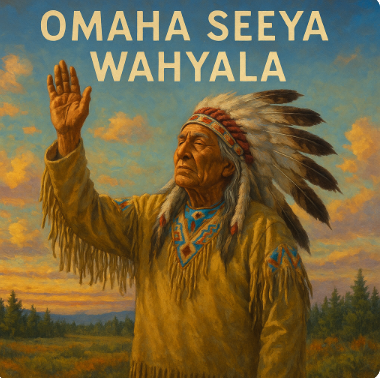Introduction
“Omaha Seeya Wahyala” is more than just a phrase—it’s a cultural expression filled with depth, history, and spiritual power. Rooted in the traditions of the Omaha Tribe, this sacred term carries centuries of meaning passed down through oral traditions, ceremonies, and community life. Understanding this expression offers a unique window into indigenous identity, spiritual values, and the importance of preserving native heritage in the modern world.
Linguistic and Cultural Origins
To understand “Omaha Seeya Wahyala,” it’s important to break down its components and cultural relevance:
| Term | Interpretation | Cultural Meaning |
|---|---|---|
| Omaha | The tribe it originates from | Refers to the Native American Omaha Tribe |
| Seeya | Spirit or spiritual call | A symbol of summoning, spiritual energy, or unity |
| Wahyala | Light or blessing | Reflects purity, guidance, and ancestral connection |
The phrase embodies values central to Omaha belief systems—unity, respect, ancestral wisdom, and the presence of spiritual forces in everyday life. It is often used in a reverent tone, showing its importance during sacred and personal moments.
Traditional Significance
Ceremonial Usage
“Omaha Seeya Wahyala” plays a vital role in Omaha ceremonies. It is used not only as a greeting but also as a spiritual invocation.
Here’s how it functions in various traditional contexts:
- Seasonal Ceremonies – During planting or harvest times, the phrase is spoken to ask for guidance from ancestors and blessings from nature.
- Rites of Passage – In events like naming ceremonies, coming-of-age rituals, marriages, or funerals, the phrase is often recited to mark transition and spiritual protection.
- Healing Ceremonies – It is sometimes chanted or softly spoken during healing rituals to bring peace and restore energy.
- Peace Gatherings – The phrase is invoked during peace agreements or tribal meetings to symbolize unity and calmness.
These sacred usages show how deeply “Omaha Seeya Wahyala” is woven into the spiritual life of the tribe.
Role in Storytelling and Oral Traditions
The Omaha Tribe has preserved its values and traditions through oral storytelling, and “Omaha Seeya Wahyala” is often a recurring theme in these narratives. Elders use it to teach younger generations about respect, the spiritual world, and the importance of cultural memory.
In many stories, this phrase signals moments of change, divine intervention, or moral lessons. It can open or close stories, serving as a verbal symbol of transition between the physical and spiritual realms.
Artistic and Performance Expressions
Beyond speech, “Omaha Seeya Wahyala” has been represented in various forms of indigenous art. These expressions help keep the phrase and its significance alive across generations.
- In Music: The phrase appears in ceremonial chants and traditional Omaha songs, usually sung during group gatherings and rituals.
- In Dance: Certain dance performances, especially spiritual ones, are based on the rhythm and energy that “Omaha Seeya Wahyala” brings.
- In Visual Art: Tribal artists often incorporate symbols related to the phrase into beadwork, quilts, regalia, and pottery.
These artistic expressions ensure the phrase isn’t just heard, but also seen and felt in meaningful cultural contexts.
Contemporary Relevance
As with many indigenous expressions, “Omaha Seeya Wahyala” continues to evolve while retaining its original spiritual depth. In recent decades, the phrase has gained new platforms thanks to efforts from the Omaha community and broader indigenous advocacy.
Cultural Revitalization Efforts
- Language preservation programs now include the teaching of traditional phrases like “Omaha Seeya Wahyala.”
- Cultural festivals highlight the phrase as a symbol of heritage and community strength.
Educational Programs
Schools within and near Omaha communities often include cultural education classes that emphasize native vocabulary and expressions. Children learn what “Omaha Seeya Wahyala” means not only in words but in values and actions.
Online and Media Presence
From YouTube videos of ceremonies to social media hashtags, the phrase has found a place in modern platforms. Young tribal members and cultural educators use digital tools to share its message, helping it reach wider and younger audiences.
Symbolism and Core Values
“Omaha Seeya Wahyala” is a phrase filled with layered meaning, and its symbolic role cannot be overstated. It stands as a verbal representation of the tribe’s most cherished values:
| Core Value | How “Omaha Seeya Wahyala” Reflects It |
|---|---|
| Unity | Spoken to promote harmony and shared identity |
| Ancestral Wisdom | Invokes the spirits of elders and guides |
| Hope and Light | Wahyala means light—used to inspire strength and direction |
| Resilience | Carries stories of survival and endurance |
By simply saying this phrase, one affirms commitment to community, spiritual connection, and cultural survival.
Broader Cultural Impact
Although it is specific to the Omaha people, “Omaha Seeya Wahyala” has resonated with broader audiences due to its powerful message of spiritual unity and ancestral reverence. Non-indigenous communities learning about the Omaha culture often recognize this phrase as a symbol of Native American identity.
Some artists, poets, and musicians outside the tribe have respectfully acknowledged or referenced “Omaha Seeya Wahyala” in their work to highlight the importance of preserving indigenous culture.
Challenges and Preservation Efforts
Despite its importance, “Omaha Seeya Wahyala” faces several threats:
- Language Loss: As younger generations shift to English, native phrases risk fading.
- Assimilation Pressures: Mainstream culture often overshadows tribal traditions.
- Limited Documentation: Oral traditions can be lost if not actively recorded or practiced.
To combat these challenges, the Omaha community is working on:
- Recording elders’ stories and chants.
- Offering classes in the native Omaha language.
- Creating digital archives with phrases like “Omaha Seeya Wahyala” explained and preserved.
Conclusion
“Omaha Seeya Wahyala” is not just a spiritual utterance—it is a living, breathing part of Omaha identity. Its usage in ceremonies, storytelling, and everyday speech demonstrates how deeply language is tied to belief, memory, and belonging.
As efforts continue to preserve it for future generations, this phrase serves as a reminder of the power of tradition, the importance of connection, and the enduring light of ancestral wisdom.
Related Articles
Tex9.net Green IT: Your Complete Guide to Sustainable Digital Technology
Discover Life at Kimaree 7080 Highway 61 Apt 102: Comfort, Community & Convenience in Barnhart, MO
Discover TributeonPrintedPics: Turn Cherished Memories Into Beautiful Keepsakes
Gel Ooru: Exploring Its Cultural Heritage, Wellness Benefits, and Modern Uses








